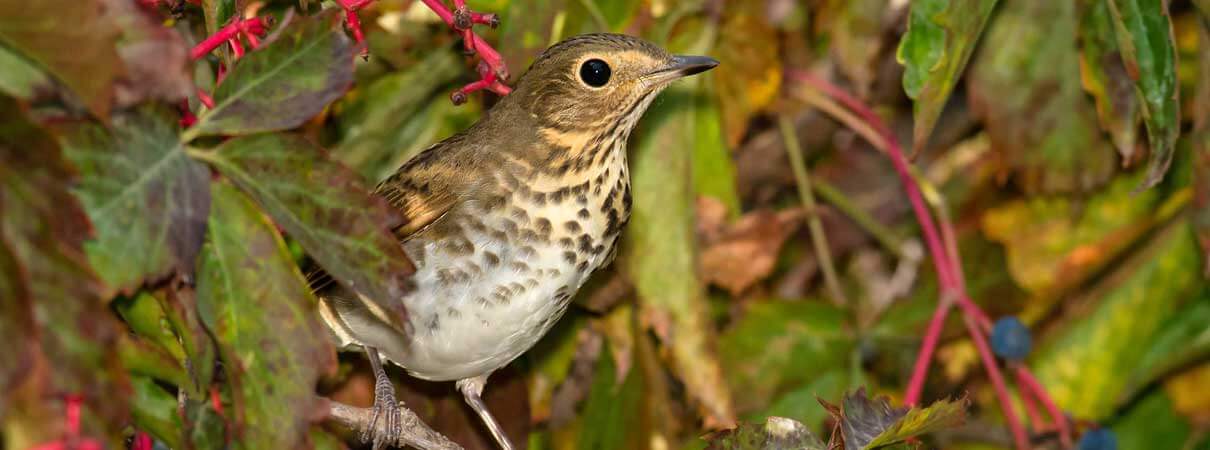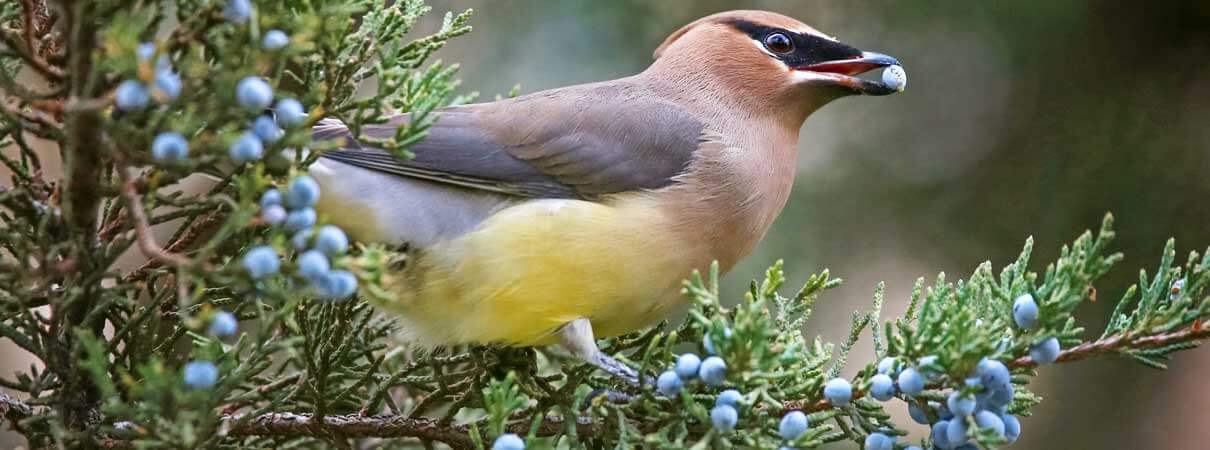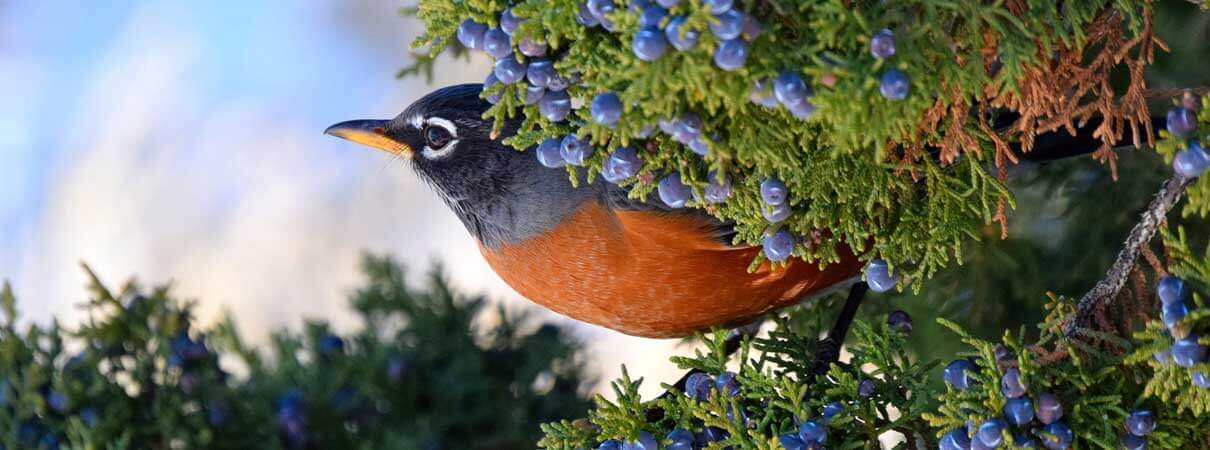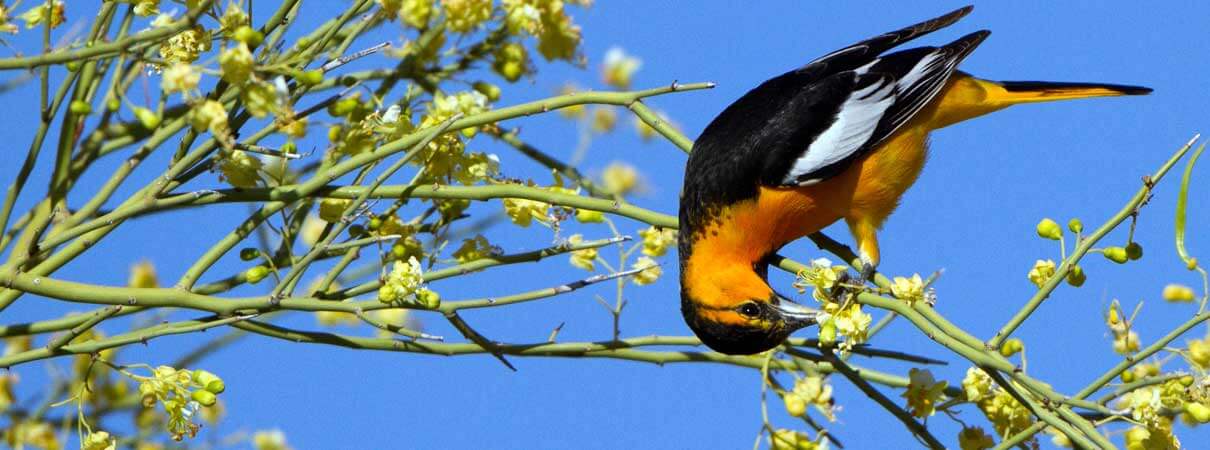Attract Birds: A Dozen Native Trees and Shrubs that Birds Love
Manicured suburban lawns just don't cut it for birds. Sure, you may see an American Robin stop by. But to attract birds to your home (and provide needed food and shelter), move beyond lawns to create a buffet of benefits for your avian neighbors. Read on for a list of a dozen kinds of plants that will have your yard bursting into song.
It's About Location … of Food
For starters, remember that to attract birds to your home, real estate is a lot about location, location, location … of food. Recent studies document widespread losses of insect life, which adversely impact bird populations. As for birds, a recent study documented how suburban birds need native plants — which host native insects — to thrive.
As natural habitats dwindle, especially around large urban centers, suburban and urban residents need to up their game for wildlife. It can be a lifesaver for birds that are losing habitat to development. Kay Charter, Founder and Executive Director of Saving Birds Thru Habitat, has some encouraging words on every individual's effort to attract birds and provide habitat:
“Every single person who owns a piece of property of any size can make a difference. They can begin by removing non-native plant species on their land and replacing them with natives. Why native plants? Native plants are important for many reasons, but they are essential as virtually the only hosts for many native insects. Insects are essential food for many birds, particularly nesting songbirds. … A small yard, even in the heart of a city, can provide these crucial sites.”

Swainson's Thrush in Virginia Creeper, a native vine that produces fruits beloved by many birds. Photo by Paul Reeves Photography/Shutterstock
Kay and her husband Jim established the 45-acre Charter Sanctuary near Omena, Mich., where more than 60 bird species have nested. The Charters have worked hard to keep native plants going strong and to provide an educational opportunity for others. Charter explains why native plants are the best choice for breeding birds:
“Baby birds, like baby humans, must have the building blocks of protein in order to develop and grow into healthy fledglings. … [they get] that necessary protein from insects. Insufficient insect food results in underweight or fewer fledglings, or, worse, failed nests.”
Top Options to Attract Birds With Native Plants
Planting bird- and insect-friendly native trees and shrubs is a great way to get started now on a property that will sustain wintering, migrating, and breeding birds. Here are a few examples of native trees and shrubs that attract birds and make out-sized contributions to suburban habitats in the East.
1. Oaks: In his book Bringing Nature Home, Douglas Tallamy writes that “oaks are the quintessential wildlife plants: no other plant genus supports more species of Lepidoptera [butterflies and moths], thus providing more types of bird food, than the mighty oak.” If you have the space, by all means, plant one!
2. Willows: Weeping Willows are nonnative, but there are many native willow species, such as Black Willow and Pussy Willow. These shrubs or small trees may be found at native plant suppliers. Many moths and butterflies are attracted to these moisture-loving plants, which can be used in borders.
3. Cherries: Native cherries, such as Black Cherry and Common Chokecherry, provide not only food for birds but leaves that feed many types of caterpillars, from the large and striking Cecropia Moth to the abundant Eastern Tent Caterpillar. Cuckoos, orioles, and many other woodland birds feed on tent caterpillars, while gnatcatchers pull away some of the caterpillar nests' silk for their own cup nests. (Bear in mind that many commonly available ornamental cherry trees, such as Yoshino Cherry, are not native.)
4. Birches: The complicated, peeling bark shelters many invertebrates, while the leaves attract hundreds of butterfly and moth species. Seeds and buds of these rather small, somewhat short-lived trees attract birds and small mammals. The adaptable River Birch is one of our favorites.
5. Dogwoods: Insects come to the flowers, and birds to the fall berries. There are eastern and western dogwood species, and trees as well as many shrubs, including the lovely-in-all-seasons Red-twig Dogwood. (Note that Flowering Dogwood is native, but Kousa Dogwood is not.)
6. Hollies: Many of these trees and shrubs are evergreen, providing year-round shelter, nesting places, and berries that ripen late fall or into winter. Choose from trees such as American Holly or the deciduous shrub, Winterberry. (Although birds love them, remember that holly berries are toxic to humans and pets.)
7. Elderberry: The elderberries are shrubs or small trees that provide abundant flowers for insects, along with summer berries beloved by people and birds alike. You'll have to be fast if you want to keep some for yourself!
8. Mulberry: In summer, birds flock to the fruits, after insects have crowded spring flowers. Choose the native Red, not the invasive, introduced White Mulberry.

Cedar Waxwings rely on the fruits of native juniper. Photo by Annette Sheaff/Shutterstock
9. Juniper (including redcedars): These shrubs and trees produce berry-like fruiting bodies and year-round cover. Eastern Redcedar fruits are a staple for Cedar Waxwings.
10. Viburnums: These shrubs grow in the forest understory, attract myriad invertebrates to their flowers and leaves, and produce berries and nesting areas for a wide variety of songbirds. Be sure to choose species native to your area. We particularly like Arrowwood Viburnum.
11. Shadbush or Serviceberry: From flowers to fruits to nesting cover, the Amelanchier family offers small trees and shrubs that are among the most popular with wildlife habitat aficionados. There are many species, but it's hard to beat the tree-sized Downy Serviceberry for beauty and bird appeal.
12. Blackberry and Raspberry: Attractive to many insects, these thorny plants also create brambles that provide cover and nesting places, while producing berries in summer. Be careful not to confuse these with the similar, but red-stemmed invasive exotic called Wineberry.
A Note to Southwest Gardeners
From a gardening point of view, the Southwest is a different world from the rest of the United States, and rich in bird-habitat opportunities. Much of what's lacking in surrounding country – namely water – is available right at home.
A clean water feature such as a recirculating shallow bath or pond will attract birds, including coveys of Gambel's or Scaled Quail. Plus, the region is rich in cacti, agave, the thorny shrub Ocotillo (which can be cut and planted to make living fences), and other flowering plants that draw hummingbirds and orioles. Do some homework on native bird-attracting plants, then contact your local nurseries.
Another plus in the Southwest: xeriscaping is popular as a water-saving measure. Rocky yards planted with native species attract more invertebrates and lizards than do water-starved turf lawns, which means that predators such as Greater Roadrunners, Loggerhead Shrikes, and raptors may come calling.
If you're able, visit our partners Tucson Audubon and the ABC-supported Paton Center for Hummingbirds, a beautiful Arizona garden and nature sanctuary.
Share Your Stories!
Are you already implementing some of these ideas in your yard? How's it going? Which birds are you benefiting? We would love to hear from you and to share your stories. Please contact us via email: info@abcbirds.org.
If you're ready for more ideas, see our prior post for additional ways to create a bird-friendly yard. And see our top ways to help birds, indoors and out.
 Howard Youth is ABC's Senior Writer/Editor. He has been a birder for 40 years – and a native plant gardener for just about as long. Howard volunteers in parks near his home in Maryland, cutting back invasive exotic plants so they do not overwhelm important bird habitats.
Howard Youth is ABC's Senior Writer/Editor. He has been a birder for 40 years – and a native plant gardener for just about as long. Howard volunteers in parks near his home in Maryland, cutting back invasive exotic plants so they do not overwhelm important bird habitats.




















































